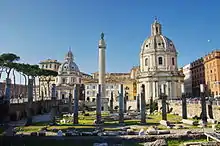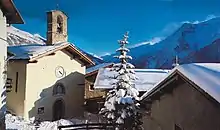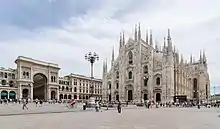Comune
The comune (Italian pronunciation: [koˈmuːne]; plural: comuni [koˈmuːni]) is a local administrative division of Italy, roughly equivalent to a township or municipality.[1] It is the third-level administrative division of Italy, after regions (regioni) and provinces (province). The comune can also have the title of città ('city').[2]
| Municipalities of Italy Comuni (Italian) | |
|---|---|
| Category | Regionalised unitary state |
| Location | Italian Republic |
| Number | 7,904 |
| Populations | 32 (Morterone) – 2,758,454 (Rome) |
| Areas | 0.1206 km2 (0.0466 sq mi) (Atrani) – 1,287.36 km2 (497.05 sq mi) (Rome) |
| Government |
|
| Subdivisions |
|
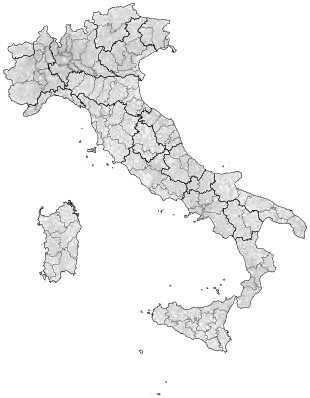
- Regions (black borders)
- Provinces (dark gray borders)
- Comuni (light grey borders)
Formed praeter legem according to the principles consolidated in medieval municipalities,[3] the comune is provided for by art. 114 of the Constitution of the Italian Republic.[4] It can be divided into frazioni, which in turn may have limited power due to special elective assemblies.[5]
In the autonomous region of the Aosta Valley, a comune is officially called a commune in French.
Overview
The comune provides essential public services: registry of births and deaths, registry of deeds, and maintenance of local roads and public works.[6][7][8] Many comuni have a Polizia Comunale (communal police), which is responsible for public order duties.[9] The comune also deal with the definition and compliance with the piano regolatore generale (general regulator plan), a document that regulates the building activity within the communal area.[10]
All communal structures or schools, sports and cultural structures such as communal libraries, theaters, etc. are managed by the comuni.[11] Comuni must have their own communal statute and have a climatic and seismic classification of their territory for the purposes of prevention and civil protection.[12] Comuni also deal with the waste management.[13]
It is headed by a mayor (sindaco or sindaca) assisted by a legislative body, the consiglio comunale (communal council), and an executive body, the giunta comunale (communal committee).[14] The mayor and members of the consiglio comunale are elected together by resident citizens: the coalition of the elected mayor (who needs a relative majority or an absolute majority in the first or second round of voting, depending on the population) gains three fifths of the consiglio's seats.[15]
The giunta comunale is chaired by the mayor, who appoints others members, called assessori, one of whom serves as deputy mayor (vicesindaco).[16] The offices of the comune are housed in a building usually called the municipio, or palazzo comunale ("town hall").[17]
As of January 2021, there were 7,904 comuni in Italy;[18] they vary considerably in size and population. For example, the comune of Rome, in Lazio, has an area of 1,287.36 km2 (497.05 sq mi) and a population of 2,758,454 inhabitants, and is both the largest and the most populated.[19]
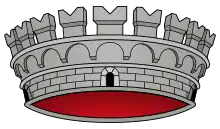
Atrani in the province of Salerno (Campania) was the smallest comune by area, with only 0.1206 km2 (0.0466 sq mi),[20] and Morterone (Lombardy) is the smallest by population.[21] Many present-day comuni trace their roots along timescales spanning centuries and at times millennia.[22][23]
The northernmost comune is Predoi, the southernmost one Lampedusa e Linosa, the westernmost Bardonecchia and the easternmost Otranto.[24] The comune with the longest name is San Valentino in Abruzzo Citeriore,[25] while the comuni with the shortest name are Lu, Ro, Ne, Re and Vo'[26]
The population density of the comuni varies widely by province and region. The province of Barletta-Andria-Trani, for example, has 381,091 inhabitants in 10 comuni,[27] or over 39,000 inhabitants per comune; whereas the province of Isernia has 81,415 inhabitants in 52 comuni,[28] or 1,640 inhabitants per comune – roughly 24 times more communal units per inhabitant.
The coats of arms of the comuni are assigned by decree of the President of the Council of Ministers of the Italian Republic by the Office of State Ceremonial and Honors, Honors and Heraldry Service (division of the Presidency of the Council born from the transformation of the Royal Consulta Araldica, suppressed pursuant to the provisions final of the Constitution of the Italian Republic).[29]
Subdivisions
| Year | Number | Population | Pop/Comune |
|---|---|---|---|
| 1861 | 7,720 | 22,171,946 | 2,872 |
| 1871 | 8,383 | 27,295,509 | 3,256 |
| 1881 | 8,260 | 28,951,546 | 3,505 |
| 1901 | 8,263 | 32,963,316 | 3,989 |
| 1911 | 8,324 | 35,841,563 | 4,306 |
| 1921 | 9,195 | 39,396,757 | 4,285 |
| 1931 | 7,311 | 41,043,489 | 5,614 |
| 1936 | 7,339 | 42,398,489 | 5,777 |
| 1951 | 7,810 | 47,515,537 | 6,084 |
| 1961 | 8,035 | 50,623,569 | 6,300 |
| 1971 | 8,056 | 54,136,547 | 6,720 |
| 1981 | 8,086 | 56,556,911 | 6,994 |
| 1991 | 8,100 | 56,885,336 | 7,023 |
| 2001 | 8,101 | 56,995,744 | 7,036 |
| 2011 | 8,092 | 59,433,744 | 7,345 |
| 2021 | 7,904 | 59,236,213 | 7,494 |
Administrative subdivisions within comuni vary according to their population size.
Comuni with at least 250,000 residents are divided into circoscrizioni[31] (roughly equivalent to French arrondissements or London boroughs) to which the comune delegates administrative functions like the running of schools, social services and waste collection; the delegated functions vary from comune to comune. These bodies are headed by an elected president and a local council.
Smaller comuni usually comprise:
- A main city, town or village, that almost always gives its name to the comune; such a place is referred to as the capoluogo ('head-place' or 'capital'; cf. the French chef-lieu) of the comune; the word comune is also used in casual speech to refer to the city hall.
- Outlying areas often called frazioni (singular: frazione, abbreviated: fraz., literally 'fraction'), each usually centred on a small town or village. These frazioni usually never had pasts as independent settlements, but occasionally are former smaller comuni consolidated into a larger one. They may also represent settlements which predate the capoluogo. The ancient town of Pollentia (today Pollenzo), for instance, is a frazione of Bra. In recent years the frazioni have become more important due to the institution of the consiglio di frazione (fraction council), a local form of government which can interact with the comune to address local needs, requests and claims. Even smaller places are called località ('localities', abbreviated: loc.).
- Smaller administrative divisions called municipi,[32] rioni, quartieri, terzieri, sestieri or contrade, which are similar to districts and neighbourhoods.
Sometimes a frazione might be more populated than the capoluogo; and rarely, owing to unusual circumstances (like depopulation), the town hall and its administrative functions can be moved to one of the frazioni, but the comune still retains the name of the capoluogo.
In some cases, a comune might not have a capoluogo but only some frazioni. In these cases, it is a comune sparso ('dispersed comune') and the frazione which hosts the town hall (municipio) is a sede municipale (compare county seat).
Homonymy
There are not many perfect homonymous comuni. There are only six cases in 12 comuni:[33]
- Calliano: Calliano, Piedmont and Calliano, Trentino
- Castro: Castro, Apulia and Castro, Lombardy
- Livo: Livo, Lombardy and Livo, Trentino
- Peglio: Peglio, Lombardy and Peglio, Marche
- Samone: Samone, Piedmont and Samone, Trentino
- San Teodoro: San Teodoro, Sardinia and San Teodoro, Sicily
This is mostly due to the fact the name of the province or region was appended to the name of the comune in order to avoid the confusion. Remarkably two provincial capitals share the name Reggio: Reggio nell'Emilia, the capital of the province of Reggio Emilia, in the Emilia-Romagna region, and Reggio di Calabria, the capital of the homonymous metropolitan city, in the Calabria region. Many other towns or villages are likewise partial homonyms (e.g. Anzola dell'Emilia and Anzola d'Ossola, or Bagnara Calabra and Bagnara di Romagna).
Title of city

The title of città ('city') in Italy is granted to comuni that have been awarded it by decree of the King of Italy (until 1946) or of the provisional head of state (from 1946 to 1948) or, subsequently, of the President of the Italian Republic (after 1948), on the proposal of the Ministry of the Interior, to which the comune concerned sends an application for a concession, by virtue of their historical, artistic, civic or demographic importance.[2]
The comuni endowed with the title of città usually carry the golden crown above their coat of arms, except with different provisions in the decree approving the coat of arms or in the presence). "The crown of the city ([...]) is formed by a golden circle opened by eight city gates (five visible) with two cordoned walls on the margins, supporting eight towers (five visible) joined by curtain walls, all in gold and black walled".[34]
Statistics
Largest comuni by area
The following is a list of the largest comuni in Italy, in descending order of surface area, according to ISTAT data referring to 9 October 2011.[35] The provincial capitals are highlighted in bold.
| Rank | Comune | Region | Province | Area (km²) |
|---|---|---|---|---|
| 1 | Rome | Lazio | Rome | 1,287.36 km2 (497.05 sq mi) |
| 2 | Ravenna | Emilia-Romagna | Ravenna | 653.82 km2 (252.44 sq mi) |
| 3 | Cerignola | Apulia | Foggia | 593.93 km2 (229.32 sq mi) |
| 4 | Noto | Sicily | Syracuse | 554.99 km2 (214.28 sq mi) |
| 5 | Sassari | Sardinia | Sassari | 547.04 km2 (211.21 sq mi) |
| 6 | Monreale | Sicily | Palermo | 530.18 km2 (204.70 sq mi) |
| 7 | Gubbio | Umbria | Perugia | 525.78 km2 (203.00 sq mi) |
| 8 | Foggia | Apulia | Foggia | 509.26 km2 (196.63 sq mi) |
| 9 | L'Aquila | Abruzzo | L'Aquila | 473.91 km2 (182.98 sq mi) |
| 10 | Grosseto | Tuscany | Grosseto | 473.55 km2 (182.84 sq mi) |
| 11 | Perugia | Umbria | Perugia | 449.51 km2 (173.56 sq mi) |
| 12 | Ragusa | Sicily | Ragusa | 444.67 km2 (171.69 sq mi) |
| 13 | Altamura | Apulia | Bari | 431.38 km2 (166.56 sq mi) |
| 14 | Caltanissetta | Sicily | Caltanissetta | 421.25 km2 (162.65 sq mi) |
| 15 | Venice | Veneto | Venice | 415.90 km2 (160.58 sq mi) |
| 16 | Viterbo | Lazio | Viterbo | 406.23 km2 (156.85 sq mi) |
| 17 | Ferrara | Emilia-Romagna | Ferrara | 405.16 km2 (156.43 sq mi) |
| 18 | Andria | Apulia | Barletta-Andria-Trani | 402.89 km2 (155.56 sq mi) |
| 19 | Matera | Basilicata | Matera | 392.09 km2 (151.39 sq mi) |
| 20 | Città di Castello | Umbria | Perugia | 387.32 km2 (149.55 sq mi) |
| 21 | Gravina in Puglia | Apulia | Bari | 384.74 km2 (148.55 sq mi) |
| 22 | Arezzo | Tuscany | Arezzo | 384.70 km2 (148.53 sq mi) |
| 23 | Olbia | Sardinia | Sassari | 383.64 km2 (148.12 sq mi) |
| 24 | Caltagirone | Sicily | Catania | 383.38 km2 (148.02 sq mi) |
| 25 | Manciano | Tuscany | Grosseto | 372.51 km2 (143.83 sq mi) |
| 26 | Enna | Sicily | Enna | 358.75 km2 (138.51 sq mi) |
| 27 | Manfredonia | Apulia | Foggia | 354.54 km2 (136.89 sq mi) |
| 28 | Spoleto | Umbria | Perugia | 348.14 km2 (134.42 sq mi) |
| 29 | Corigliano-Rossano | Calabria | Cosenza | 346.56 km2 (133.81 sq mi) |
| 30 | Cortona | Tuscany | Arezzo | 342.97 km2 (132.42 sq mi) |
Smallest comuni by area
The following is a list of the smallest comuni in Italy, in ascending order of surface area, according to ISTAT data referring to 9 October 2011.[35]
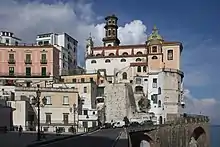
| Rank | Comune | Region | Province | Area (km²) |
|---|---|---|---|---|
| 1 | Atrani | Campania | Salerno | 0.1206 km2 (0.0466 sq mi) |
| 2 | Miagliano | Piedmont | Biella | 0.6678 km2 (0.2578 sq mi) |
| 3 | Fiorano al Serio | Lombardy | Bergamo | 1.0601 km2 (0.4093 sq mi) |
| 4 | Conca dei Marini | Campania | Salerno | 1.1281 km2 (0.4356 sq mi) |
| 5 | Roccafiorita | Sicily | Messina | 1.1682 km2 (0.4510 sq mi) |
| 6 | Solza | Lombardy | Bergamo | 1.2278 km2 (0.4741 sq mi) |
| 7 | Maslianico | Lombardy | Como | 1.2885 km2 (0.4975 sq mi) |
| 8 | San Lorenzo al Mare | Liguria | Imperia | 1.2886 km2 (0.4975 sq mi) |
| 9 | Crosio della Valle | Lombardy | Varese | 1.4407 km2 (0.5563 sq mi) |
| 10 | Ferrera di Varese | Lombardy | Varese | 1.5265 km2 (0.5894 sq mi) |
| 11 | Casavatore | Campania | Naples | 1.5267 km2 (0.5895 sq mi) |
| 12 | Piario | Lombardy | Bergamo | 1.5451 km2 (0.5966 sq mi) |
| 14 | Vajont | Friuli-Venezia Giulia | Pordenone | 1.5860 km2 (0.6124 sq mi) |
| 15 | Arizzano | Piedmont | Verbano-Cusio-Ossola | 1.5995 km2 (0.6176 sq mi) |
| 16 | Longone al Segrino | Lombardy | Como | 1.6045 km2 (0.6195 sq mi) |
| 17 | Viganò | Lombardy | Lecco | 1.6049 km2 (0.6197 sq mi) |
| 18 | Brunello | Lombardy | Varese | 1.6200 km2 (0.6255 sq mi) |
| 19 | Camparada | Lombardy | Monza e Brianza | 1.6337 km2 (0.6308 sq mi) |
| 20 | Caines | Trentino-Alto Adige | South Tyrol | 1.6345 km2 (0.6311 sq mi) |
| 21 | Curti | Campania | Caserta | 1.6894 km2 (0.6523 sq mi) |
| 22 | Castel Rozzone | Lombardy | Bergamo | 1.7066 km2 (0.6589 sq mi) |
| 23 | Lozza | Lombardy | Varese | 1.7100 km2 (0.6602 sq mi) |
| 24 | Aci Bonaccorsi | Sicily | Catania | 1.7243 km2 (0.6658 sq mi) |
| 25 | Calvignasco | Lombardy | Milan | 1.7272 km2 (0.6669 sq mi) |
| 26 | Ventotene | Lazio | Latina | 1.7454 km2 (0.6739 sq mi) |
| 27 | Lirio | Lombardy | Pavia | 1.7457 km2 (0.6740 sq mi) |
| 28 | Masciago Primo | Lombardy | Varese | 1.8082 km2 (0.6981 sq mi) |
| 29 | Montello | Lombardy | Bergamo | 1.8156 km2 (0.7010 sq mi) |
| 30 | Carzano | Trentino-Alto Adige | Trentino | 1.8202 km2 (0.7028 sq mi) |
Highest comuni by altitude
The following is a list of the first comuni by altitude, in descending order.[36] The indicated altitude coincides with the height above sea level of the town hall.
| Rank | Comune | Region | Province | Altitude (Meters above the sea level) |
|---|---|---|---|---|
| 1 | Sestriere | Piedmont | Turin | 2,035 m (6,677 ft) |
| 2 | Chamois | Aosta Valley | — | 1,818 m (5,965 ft) |
| 3 | Livigno | Lombardy | Sondrio | 1,816 m (5,958 ft) |
| 4 | Claviere | Piedmont | Turin | 1,760 m (5,770 ft) |
| 5 | Rhêmes-Notre-Dame | Aosta Valley | — | 1,725 m (5,659 ft) |
| 6 | Ayas | Aosta Valley | — | 1,699 m (5,574 ft) |
| 7 | Argentera | Piedmont | Cuneo | 1,684 m (5,525 ft) |
| 8 | Valgrisenche | Aosta Valley | — | 1,664 m (5,459 ft) |
| 9 | La Magdeleine | Aosta Valley | — | 1,644 m (5,394 ft) |
| 10 | Elva | Piedmont | Cuneo | 1,637 m (5,371 ft) |
| 11 | Gressoney-La-Trinité | Aosta Valley | — | 1,635 m (5,364 ft) |
| 12 | Ceresole Reale | Piedmont | Turin | 1,620 m (5,310 ft) |
| 13 | Pontechianale | Piedmont | Cuneo | 1,614 m (5,295 ft) |
| 14 | Bionaz | Aosta Valley | — | 1,606 m (5,269 ft) |
| 15 | Bellino | Piedmont | Cuneo | 1,572 m (5,157 ft) |
| 16 | Corvara in Badia | Trentino-Alto Adige | South Tyrol | 1,568 m (5,144 ft) |
| 17 | Selva di Val Gardena | Trentino-Alto Adige | South Tyrol | 1,563 m (5,128 ft) |
| 18 | Sauze di Cesana | Piedmont | Turin | 1,560 m (5,120 ft) |
| 19 | Cogne | Aosta Valley | — | 1,544 m (5,066 ft) |
| 20 | Valsavarenche | Aosta Valley | — | 1,541 m (5,056 ft) |
| 21 | Valtournenche | Aosta Valley | — | 1,528 m (5,013 ft) |
| 22 | Pragelato | Piedmont | Turin | 1,524 m (5,000 ft) |
| 23 | Curon Venosta | Trentino-Alto Adige | South Tyrol | 1,520 m (4,990 ft) |
| 24 | Saint-Rhémy-en-Bosses | Aosta Valley | — | 1,519 m (4,984 ft) |
| 25 | Sauze d'Oulx | Piedmont | Turin | 1,509 m (4,951 ft) |
| 26 | Foppolo | Lombardy | Bergamo | 1,508 m (4,948 ft) |
| 27 | Torgnon | Aosta Valley | — | 1,489 m (4,885 ft) |
| 28 | Predoi | Trentino-Alto Adige | South Tyrol | 1,475 m (4,839 ft) |
| 29 | Livinallongo del Col di Lana | Veneto | Belluno | 1,475 m (4,839 ft) |
| 30 | Canazei | Trentino-Alto Adige | Trentino | 1,465 m (4,806 ft) |
Largest comuni by population
List of the first comuni by population in descending order, according to ISTAT data updated to 28 February 2022.[37] The regional capitals are in bold.
| Rank | Comune | Region | Province | Inhabitants |
|---|---|---|---|---|
| 1 | Rome | Lazio | Rome | 2,758,454 |
| 2 | Milan | Lombardy | Milan | 1,371,606 |
| 3 | Naples | Campania | Naples | 912,954 |
| 4 | Turin | Piedmont | Turin | 846 067 |
| 5 | Palermo | Sicily | Palermo | 628 883 |
| 6 | Genoa | Liguria | Genoa | 560 155 |
| 7 | Bologna | Emilia-Romagna | Bologna | 392,593 |
| 8 | Florence | Tuscany | Florence | 367,051 |
| 9 | Bari | Apulia | Bari | 316,113 |
| 10 | Catania | Sicily | Catania | 297,761 |
| 11 | Verona | Veneto | Verona | 257,176 |
| 12 | Venice | Veneto | Venice | 254,367 |
| 13 | Messina | Sicily | Messina | 219,565 |
| 14 | Padua | Veneto | Padua | 208,561 |
| 15 | Prato | Tuscany | Prato | 200,647 |
| 16 | Trieste | Friuli-Venezia Giulia | Trieste | 200,454 |
| 17 | Parma | Emilia-Romagna | Parma | 196,982 |
| 18 | Brescia | Lombardy | Brescia | 196,727 |
| 19 | Taranto | Apulia | Taranto | 188,848 |
| 20 | Modena | Emilia-Romagna | Modena | 185,628 |
| 21 | Reggio Calabria | Calabria | Reggio Calabria | 171,546 |
| 22 | Reggio Emilia | Emilia-Romagna | Reggio Emilia | 169,100 |
| 23 | Perugia | Umbria | Perugia | 163,614 |
| 24 | Ravenna | Emilia-Romagna | Ravenna | 155,968 |
| 25 | Livorno | Tuscany | Livorno | 153,901 |
| 26 | Rimini | Emilia-Romagna | Rimini | 150,068 |
| 27 | Cagliari | Sardinia | Cagliari | 148,697 |
| 28 | Foggia | Apulia | Foggia | 146,213 |
| 29 | Ferrara | Emilia-Romagna | Ferrara | 131,066 |
| 30 | Salerno | Campania | Salerno | 127,840 |
Comuni by demographic ranges
The data is updated as of 1 January 2021.[38]
_alt_colours.jpg.webp)
| Demographic range | Comuni | Population | ||
|---|---|---|---|---|
| Number | % | Residents | % | |
| more than 500,000 inhab. | 6 | 0,08% | 7,170,310 | 12.10% |
| from 250,000 to 499,999 inhab. | 6 | 0.08% | 1,874,966 | 3.16% |
| from 100,000 to 249,999 inhab. | 32 | 0.40% | 4,749,945 | 8.02% |
| from 60,000 to 99,999 inhab. | 58 | 0.73% | 4,446,634 | 7.50% |
| from 20,000 to 59,999 inhab. | 404 | 5.11% | 13,253,362 | 22.37% |
| from 10,000 to 19,999 inhab. | 698 | 8.83% | 9,662,013 | 16.31% |
| from 5,000 to 9,999 inhab. | 1,179 | 14.92% | 8,331,631 | 14.06% |
| from 3,000 to 4,999 inhab. | 1,087 | 13.75% | 4,222,171 | 7.13% |
| from 2,000 to 2,999 inhab. | 921 | 11.65% | 2,258,907 | 3.81% |
| from 1,000 to 1,999 inhab. | 1,520 | 19.23% | 2,213,443 | 3.74% |
| from 500 to 999 inhab. | 1,101 | 13.93% | 811,919 | 1.37% |
| less than 500 inhab. | 892 | 11.29% | 262,265 | 0.44% |
| Total | 7,904 | 100.00% | 59,257,566 | 100.00% |
Demographic ranges by macroregion
The data is updated as of 1 January 2021.[38]
| Demographic range | Number of comuni | Resident population | ||||
|---|---|---|---|---|---|---|
| North | Centre | South | North | Centre | South | |
| more than 500,000 inhab. | 3 | 1 | 2 | 2,804,841 | 2,783,809 | 1,581,660 |
| from 250,000 to 499,999 inhab. | 3 | 1 | 2 | 907,910 | 359,755 | 607,301 |
| from 100,000 to 249,999 inhab. | 17 | 5 | 10 | 2,503,474 | 749,523 | 1,496,948 |
| from 60,000 to 99,999 inhab. | 16 | 16 | 26 | 1,289,906 | 1,253,707 | 1,903,021 |
| from 20,000 to 59,999 inhab. | 158 | 78 | 168 | 4,974,716 | 2,647,385 | 5,631,261 |
| from 10,000 to 19,999 inhab. | 353 | 115 | 230 | 4,824,497 | 1,655,230 | 3,182,286 |
| from 5,000 to 9,999 inhab. | 672 | 155 | 352 | 4,723,268 | 1,139,230 | 2,469,133 |
| from 3,000 to 4,999 inhab. | 620 | 141 | 326 | 2,404,254 | 549,864 | 1,268,053 |
| from 2,000 to 2,999 inhab. | 501 | 100 | 320 | 1,229,705 | 242,581 | 786,621 |
| from 1,000 to 1,999 inhab. | 793 | 182 | 545 | 1,155,222 | 270,306 | 787,915 |
| from 500 to 999 inhab. | 627 | 110 | 364 | 458,324 | 82,312 | 271,283 |
| less than 500 inhab. | 622 | 64 | 206 | 175,415 | 19,431 | 67,419 |
| Total | 4,385 | 968 | 2,551 | 27,451,532 | 11,753,133 | 20,052,901 |
See also
- Regions of Italy
- Metropolitan cities of Italy
- Provinces of Italy
- List of municipalities of Italy
- List of renamed municipalities in Italy
- Alphabetical list of municipalities of Italy
- Fusion of municipalities of Italy
- Municipalities of Switzerland – those in Italian-speaking areas of the country are called comuni
References
- "Italian communes ordered alphabetically". Retrieved 3 May 2022.
- "Testo unico delle leggi sull'ordinamento degli enti locali" (in Italian). Retrieved 4 May 2022.
- "CONSUETUDINE" (in Italian). Retrieved 6 May 2022.
- "La Costituzione - Articolo 114" (in Italian). Retrieved 6 May 2022.
- "DECRETO N. 15 DEL 14/11/2019" (PDF) (in Italian). Retrieved 6 May 2022.
- "Gli adempimenti degli uffici Anagrafe" (in Italian). Retrieved 3 May 2022.
- "Poteri e compiti degli enti proprietari delle strade" (in Italian). Retrieved 3 May 2022.
- "Settore Lavori pubblici e manutenzione della città" (in Italian). Retrieved 3 May 2022.
- "Cosa fa polizia locale" (in Italian). Retrieved 3 May 2022.
- "Che cos'è un piano regolatore?" (in Italian). Retrieved 6 May 2022.
- "Cultura" (in Italian). Retrieved 3 May 2022.
- "Protezione Civile del Comune di Prato" (in Italian). Retrieved 3 May 2022.
- "I Comuni, per i rifiuti prodotti nel proprio territorio, a quali vincoli normativi sono soggetti in merito a raccolta e trasporto?" (in Italian). Retrieved 6 May 2022.
- "Funzioni e competenze del consiglio comunale" (in Italian). Retrieved 3 May 2022.
- "SISTEMA ELETTORALE COMUNI" (in Italian). Retrieved 3 May 2022.
- "Funzioni della Giunta" (in Italian). Retrieved 3 May 2022.
- "Municipio" (in Italian). Retrieved 3 May 2022.
- "Regioni italiane" (in Italian). Retrieved 30 April 2022.
- "Alcune curiosità sui comuni italiani" (in Italian). Retrieved 3 May 2022.
- "Atrani: le tante facce del più piccolo comune italiano" (in Italian). Retrieved 3 May 2022.
- "Comune che "vince" non si cambia: 29 abitanti, Morterone è ancora il più piccolo d'Italia" (in Italian). Retrieved 3 May 2022.
- "I comuni nel Medioevo: nascita e sviluppo tra 1200 e 1300" (in Italian). Retrieved 3 May 2022.
- "Il modello cittadino in epoca romana" (in Italian). Retrieved 3 May 2022.
- "Luoghi d'Italia da primato" (in Italian). Retrieved 6 May 2022.
- "Comuni con i nomi più lunghi". Archived from the original on 12 April 2019. Retrieved 1 April 2020.
- "Curiosità e nomi particolari" (in Italian). Retrieved 6 May 2022.
- "Provincia di Barletta-Andria-Trani" (in Italian). Retrieved 3 May 2022.
- "Provincia di Isernia" (in Italian). Retrieved 3 May 2022.
- "Ufficio del cerimoniale di Stato e per le Onorificenze" (in Italian). Retrieved 4 May 2022.
- "Comuni dal 1861". www.comuniverso.it. Retrieved 19 March 2017.
- "Circoscrizioni di decentramento comunale" (in Italian). Retrieved 3 May 2022.
- "L'affluenza, municipio per municipio, a Milano, Roma e Napoli: ecco quali zone hanno votato di più" (in Italian). Retrieved 3 May 2022.
- (in Italian) Complete list and infos on Comuni-italiani.it
- "Caratteristiche tecniche degli emblemi araldici" (in Italian). Retrieved 4 May 2022.
- "La superficie dei comuni, delle province e delle regioni italiane" (in Italian). Retrieved 4 May 2022.
- "Comuni italiani per altitudine" (in Italian). Retrieved 4 May 2022.
- "Statistiche demografiche ISTAT". Archived from the original on 22 February 2022. Retrieved 3 May 2022.
- "Comuni per fasce demografiche" (in Italian). Retrieved 4 May 2022.
External links
- Associazione Nazionale Comuni Italiani (in Italian).
 Media related to Municipalities in Italy at Wikimedia Commons
Media related to Municipalities in Italy at Wikimedia Commons The dictionary definition of comune at Wiktionary
The dictionary definition of comune at Wiktionary
